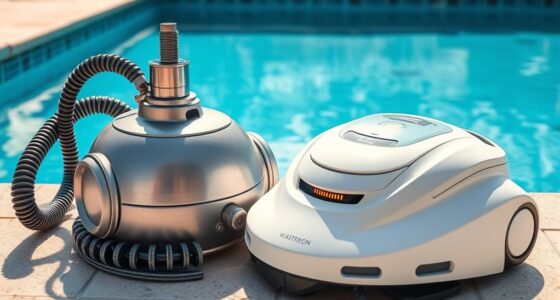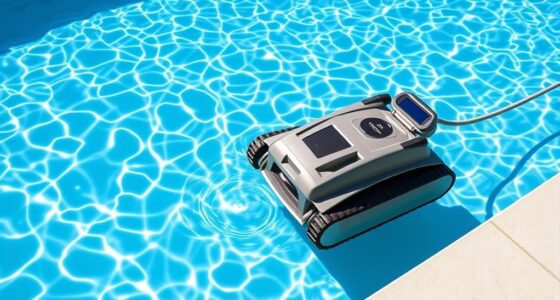You should run your suction pool cleaner daily or for about 1 to 2 hours each session, especially if your pool sees frequent use or has lots of surrounding trees and debris. During heavy storm seasons or warmer months, increasing the cleaning frequency helps keep your pool sparkling. Keep an eye on debris buildup and water clarity, and modifying your schedule accordingly ensures your pool stays in top shape. To discover more tips, continue with these insights.
Key Takeaways
- Run your suction pool cleaner daily during active swimming seasons to prevent debris buildup and maintain water clarity.
- Adjust cleaning frequency based on environmental factors like nearby trees, wind, and rainfall, which increase debris.
- For heavily used pools or with high debris levels, run the cleaner for 1-2 hours daily or as needed.
- During colder months or low usage, reduce cleaning frequency but ensure regular maintenance to prevent algae.
- Regularly monitor water chemistry and debris levels to determine if more frequent or extended cleaning sessions are necessary.
Factors That Influence Cleaning Frequency

Several factors can impact how often you should run your pool cleaner, so it’s important to contemplate your specific circumstances. One key factor is your pool’s water chemistry; if chemicals aren’t balanced, debris can accumulate faster, requiring more frequent cleaning. Water temperature also plays a role—warmer water tends to promote algae growth and bacteria, which can lead to more debris settling at the bottom. Additionally, high swimmer activity stirs up dirt and leaves, increasing cleaning needs. Heavy rain or wind can introduce debris, prompting more frequent runs. Conversely, if your pool remains relatively clean and stable in chemical levels, you might not need to run your cleaner as often. Understanding these factors helps you determine an efficient cleaning schedule tailored to your pool’s conditions. Proper pool maintenance ensures optimal cleaning frequency and longevity of your equipment, and staying aware of environmental factors can help prevent unexpected buildup. Regularly monitoring your pool’s water quality can also inform adjustments to your cleaning routine, ensuring your pool stays sparkling and safe.
Recommended Routine for Daily Pool Maintenance
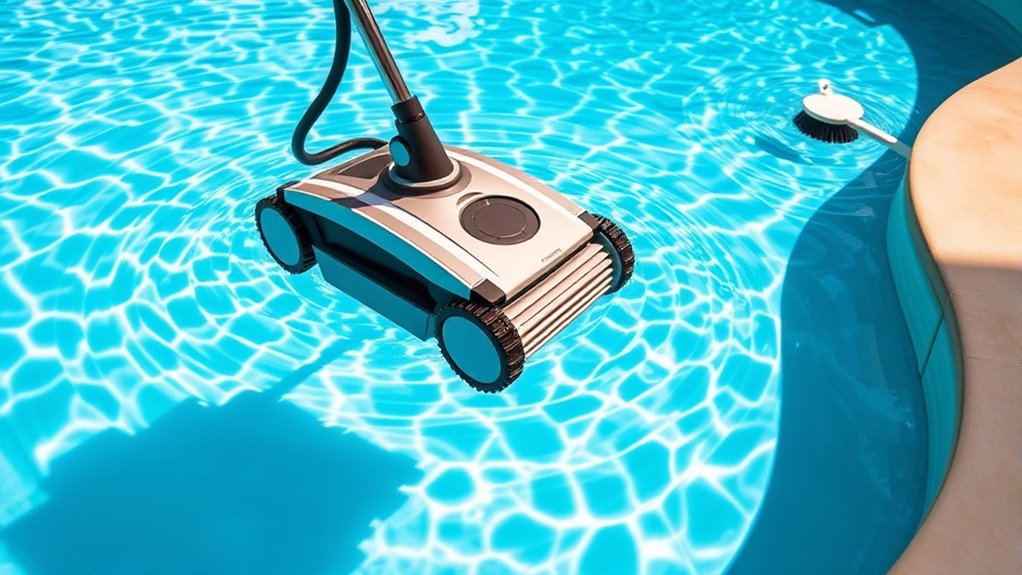
Establishing a daily cleaning routine helps keep your pool clear and inviting. Aim to run your cleaner for an ideal amount of time to prevent debris buildup without wasting energy. Consistently maintaining this schedule ensures your pool stays clean and ready for use. Incorporating a self-watering system can also reduce the frequency of manual cleaning by maintaining cleaner moisture levels and promoting overall pool health. Proper color accuracy in your pool’s lighting setup can enhance visibility during evening swims, making your pool more enjoyable. Additionally, choosing the right Kia Tuning modifications can enhance your vehicle’s performance, just as proper pool maintenance ensures optimal water quality. Employing smart water conservation features can further optimize your pool’s efficiency and sustainability.
Daily Cleaning Schedule
To keep your pool clean and safe for daily use, it’s important to incorporate a routine that includes running your pool cleaner every day. This helps maintain proper pool chemical balance by preventing debris buildup that can affect water chemistry. Regular cleaning also supports consistent pool lighting, ensuring your pool stays bright and inviting. Each day, skim the surface for leaves and debris, and check for any signs of algae or cloudiness. Running your suction pool cleaner daily helps prevent algae growth and keeps the pool floor clear of dirt. Additionally, maintaining a daily schedule promotes better circulation, which supports even distribution of chemicals and maintains overall water quality. Modern smart pool systems can automatically monitor water conditions and adjust cleaning schedules accordingly, further simplifying maintenance. Using pool automation technology can optimize your cleaning routine and save you time. Establishing a daily maintenance routine is essential for consistent pool health and longevity. A consistent routine guarantees your pool remains clean, safe, and enjoyable for everyday use. Incorporating regular filter cleaning into your routine can also enhance the effectiveness of your pool cleaner and improve water clarity. To further improve efficiency, consider adding aiding tools like pool skimmers or brushes to your daily care.
Optimal Running Duration
For effective daily pool maintenance, running your cleaner for about 1 to 2 hours is usually sufficient to keep debris under control without overworking the equipment. This duration helps maintain proper pool chemistry and ensures your equipment stays in good shape. To optimize your routine, consider these factors:
- Pool size and usage—larger or heavily used pools may need closer to 2 hours.
- Debris levels—more debris requires longer cleaning sessions.
- Equipment maintenance—avoid overworking your cleaner, which can cause wear and tear.
- Regularly inspecting your security system can help prevent unexpected issues that might disrupt your cleaning schedule.
- Understanding celebrity transformations can provide insights into how careful maintenance and upgrades prolong the lifespan of your pool equipment.
- Proper filter cleaning is also essential to ensure your suction pool cleaner operates efficiently during these sessions.
- Adjusting the running duration based on environmental conditions can further improve cleaning efficiency and equipment longevity.
Stick to this timing to balance effective debris removal with preserving your equipment’s lifespan. Regular, appropriately timed cleaning supports balanced pool chemistry and reduces the risk of equipment failure, making your pool safer and easier to maintain.
Preventing Pool Debris
Keeping debris out of your pool starts with proactive measures you can take daily. Regularly inspect and maintain your pool cover to prevent leaves and dirt from falling in. Keeping the pool chemical balance in check ensures debris doesn’t cling to surfaces or cause algae growth. Additionally, removing floating debris with a skimmer helps reduce the workload on your pool cleaner. Proper food safety practices, such as handling raw chicken carefully, can also be considered a part of overall maintenance routines to keep your environment clean and safe. Incorporating homesteading principles like composting garden waste can also help manage organic debris around your property. Regularly reviewing divorce guidelines can serve as a reminder to stay on top of ongoing maintenance and legal responsibilities to prevent future issues. Using a flat iron bike for transportation or maintenance tasks can further streamline your routine and keep your pool area tidy. Implementing water filtration techniques can also improve water clarity, reducing debris buildup and keeping your pool cleaner longer.
Adjusting Schedule Based on Pool Usage

Your pool’s cleaning schedule should reflect how often you use the water. If you swim daily, you’ll need to run your cleaner more frequently to maintain proper pool chemical balance and prevent debris buildup. Conversely, if you use the pool less often, you can extend the time between cleanings. To adjust effectively, consider these factors:
- Frequency of use – More swimmers mean more debris and faster chemical imbalance.
- Environmental factors – Nearby trees or wind can increase debris, requiring more cleaning.
- Filter maintenance needs – Regular cleaning ensures your system runs efficiently, reducing the strain on your pool cleaner.
- Type of pool cleaner – Some models, like the suction pool cleaner, require more frequent operation to stay effective.
Seasonal Considerations for Pool Cleaning
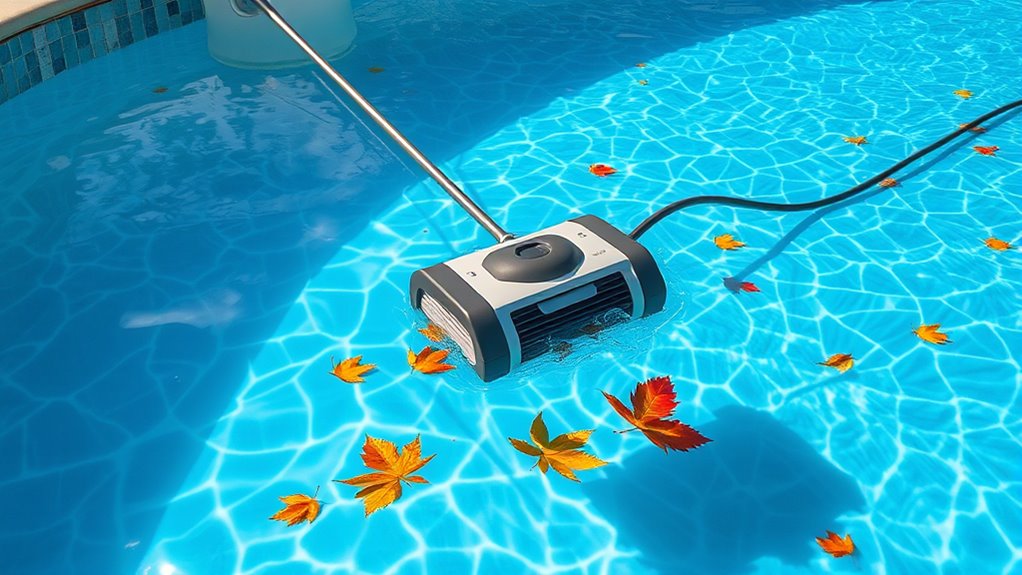
Seasonal changes considerably impact how often you should clean your pool. During warmer months, you might need to run your suction pool cleaner more frequently due to increased debris, algae growth, and overall dirt. Seasonal maintenance becomes essential to prevent buildup and keep your water clear. Weather impact also plays a role; windy or stormy seasons can bring more leaves and dirt into your pool, requiring additional cleaning cycles. Conversely, in colder months or outside peak swimming seasons, you can reduce cleaning frequency as debris tends to settle less often. Adjusting your cleaning schedule to these seasonal variations ensures your pool remains clean, balanced, and ready for use whenever you want. Proper seasonal maintenance saves time and prolongs your pool equipment’s lifespan. Additionally, using appropriate cleaning tools tailored to each season can optimize your pool care routine.
Impact of Surrounding Environment on Cleaning Needs

The surrounding environment directly influences how often you need to run your pool cleaner. Factors like chlorine levels, water temperature, and outdoor conditions impact debris and algae growth. For example, high chlorine levels help control bacteria but can cause algae if water temp rises. Consider these points:
- In warm water (above 80°F), algae blooms faster, requiring more frequent cleaning.
- If your chlorine levels are low, debris accumulates quickly, increasing cleaning frequency.
- Outdoor environments with trees or pollen shed often lead to more debris, regardless of temperature.
Signs That Indicate Your Cleaner Needs Running
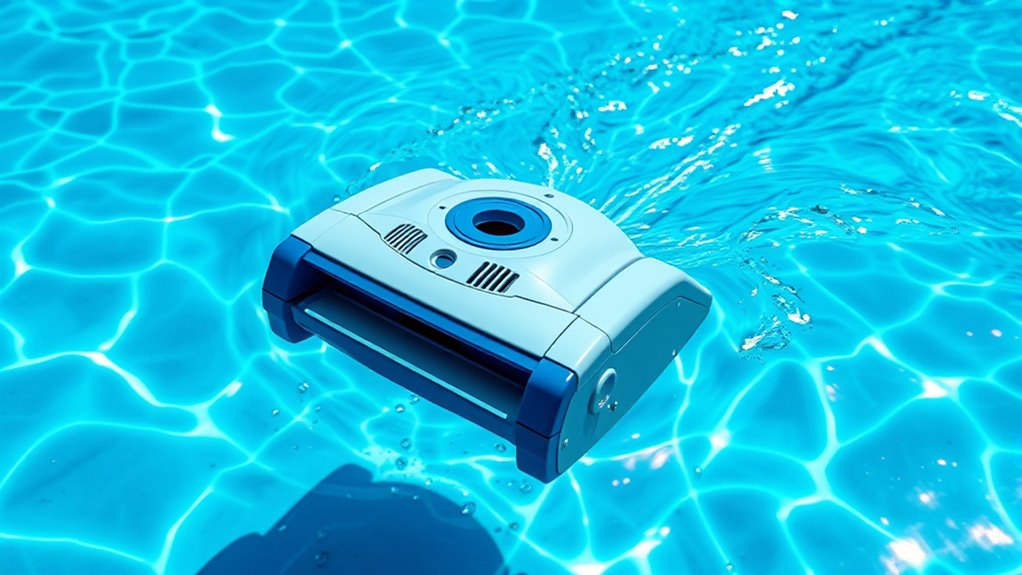
If you notice unusual debris buildup or dirt on the pool floor, your cleaner might need to run more often. Reduced performance or missed spots can also signal it’s time for a check. Keep an eye out for these signs to maintain a clean, healthy pool.
Unusual Pool Debris Accumulation
Have you noticed an unusual amount of debris floating on your pool’s surface or settled at the bottom? This can be a sign your suction pool cleaner isn’t running often enough. When debris accumulates, it indicates poor water circulation and imbalanced pool chemical levels, which can cause debris to stick around longer. Here are three signs to watch for:
- Excess leaves, bugs, or dirt settling at the bottom.
- Visible debris floating on the surface even after cleaning.
- A layer of grime or dirt that isn’t being removed by your current cleaning schedule.
If you notice these signs, it’s time to run your cleaner more frequently to keep debris in check. Proper water circulation and balanced pool chemicals help your cleaner work efficiently and prevent buildup.
Reduced Cleaning Performance
Reduced cleaning performance often becomes noticeable when your pool cleaner isn’t running as frequently as it should. You might see more pool algae growth or debris lingering on the pool bottom. Water chemistry imbalances, like high pH or low chlorine levels, can also hinder your cleaner’s effectiveness. When these issues occur, your pool cleaner struggles to pick up dirt and algae efficiently, leading to dull or cloudy water. If you notice uneven cleaning or leftover debris after a cycle, it’s a sign your cleaner isn’t working at its best. Running your cleaner regularly helps keep water chemistry balanced and prevents algae buildup, ensuring it functions properly. Addressing these signs promptly keeps your pool cleaner performing at its peak and maintains a clean, inviting pool.
Visible Dirt or Grime
When you notice patches of dirt or grime accumulating on the pool floor or walls, it’s a clear sign your cleaner isn’t running frequently enough. This buildup can be caused by imbalances in your chemical levels, allowing pool algae and debris to settle. To keep your pool spotless, watch for these signs:
- Visible patches of dirt or algae on the surface or walls.
- Increased debris settling despite previous cleaning.
- Slimy or grimy areas indicating poor circulation or chemical imbalance.
If you see these issues, it’s time to run your suction pool cleaner more often. Regular cleaning helps maintain proper chemical balance, preventing dirt and algae buildup and ensuring your pool stays crystal clear.
Best Practices for Running Your Suction Pool Cleaner

To guarantee your suction pool cleaner operates efficiently, it’s important to follow some best practices. First, ensure your pool is properly balanced by maintaining correct pool chemical levels; this prevents debris buildup that can clog your cleaner. Regularly check and adjust pH, alkalinity, and sanitizer levels. Additionally, pool heater maintenance is vital—a well-maintained heater prevents algae growth and reduces debris in the water, easing your cleaner’s workload. Before running the cleaner, clear the pool of large debris like leaves and twigs. Set a consistent schedule based on pool usage and environmental factors, typically a few times a week. Lastly, inspect the cleaner’s hose and skimmer to ensure proper operation, maximizing efficiency and prolonging your cleaner’s lifespan.
Tips to Maximize Efficiency and Longevity
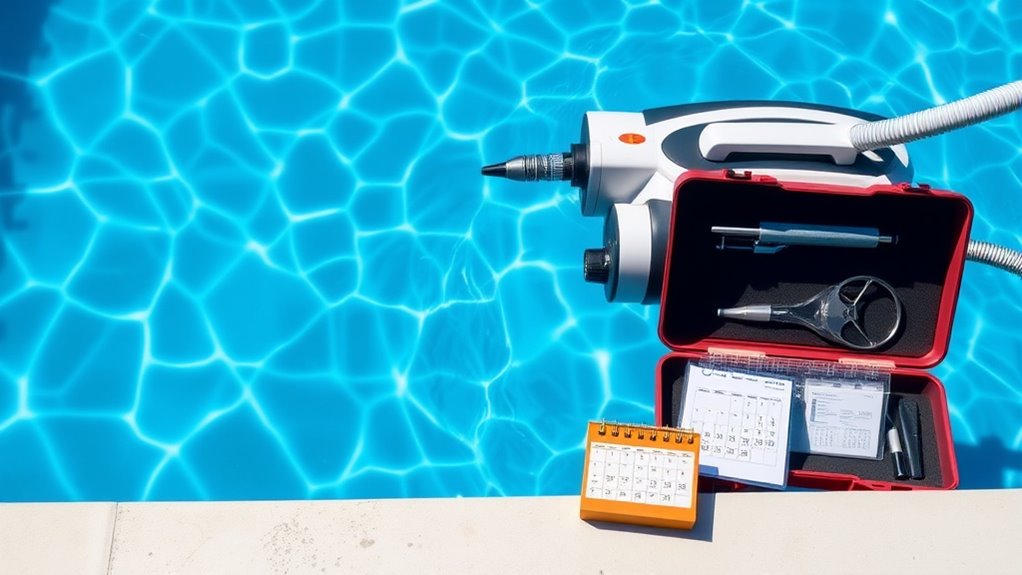
Maintaining proper cleaning habits can substantially extend the lifespan of your pool cleaner while ensuring it works efficiently. To do this, focus on three key practices. First, regularly check your pool’s chemical balance—imbalanced chemicals can cause debris buildup and damage. Second, perform routine equipment maintenance by inspecting and cleaning the cleaner’s brushes, filters, and hoses. Third, store your pool cleaner properly during off-season or when not in use, avoiding exposure to extreme weather. These steps help prevent unnecessary wear and tear, reducing the risk of malfunctions. Keeping your pool’s chemistry stable and your equipment in top shape not only maximizes cleaning efficiency but also prolongs your cleaner’s lifespan, saving you time and money in the long run.
Frequently Asked Questions
Can I Run My Suction Pool Cleaner During Guests’ Pool Use?
You can run your suction pool cleaner during guests’ pool use, but consider pool safety and energy consumption. Running it while people swim might cause minor disturbances or noise, so make certain it doesn’t interfere with safety. To save energy, run the cleaner during off-peak hours or when the pool isn’t in use. This way, you keep your pool clean without compromising safety or wasting energy.
How Does Water Temperature Affect Cleaning Frequency?
You might wonder if water temperature impacts your cleaning schedule. In truth, warmer water can promote algae growth and bacteria, meaning your pool needs more frequent cleaning. Conversely, colder water slows these processes, allowing longer intervals between cleanings. So, you should adjust your suction pool cleaner’s schedule based on water temperature—more often in warm weather, less in cooler months—to keep your pool pristine and safe for swimmers.
Should I Run My Cleaner After Heavy Rain or Storms?
After heavy rain or storms, you should run your suction pool cleaner more frequently during the rainy season. Rain causes debris accumulation, which can clog your filter and reduce cleaning efficiency. Running your cleaner helps remove leaves, dirt, and other debris, keeping your pool clean and preventing algae growth. Regular cleaning after storms guarantees your pool stays inviting and safe, especially when debris quickly builds up after heavy rainfall.
Is It Necessary to Run the Cleaner in Winter or Off-Season?
Running your suction pool cleaner in winter is like giving your pool a gentle winter blanket. During winter maintenance, you don’t need to run it frequently—perhaps once a week is enough to keep debris at bay. Off-season cleaning helps prevent algae and dirt buildup, saving you time in spring. Make sure to adjust your cleaning schedule based on weather and pool usage, ensuring your pool stays fresh year-round.
Can Running the Cleaner Too Often Damage My Pool Equipment?
Running your suction pool cleaner too often can lead to unnecessary strain on your pool equipment, increasing the risk of damage. Frequent operation may cause excessive wear, especially if debris buildup is minimal. To protect your pool equipment maintenance, balance cleaning sessions based on debris levels and pool usage. This way, you maintain a clean pool without overworking your equipment, ensuring longevity and peak performance.
Conclusion
Ultimately, how often you run your suction pool cleaner depends on your pool’s usage and environment. While regular cleaning keeps your water clear and equipment working smoothly, neglecting it can lead to costly repairs and murky water. Think of your cleaner as your pool’s health partner—consistently working behind the scenes or waiting for your neglect to show. Stay proactive, follow a routine, and enjoy sparkling, trouble-free swimming all season long.


